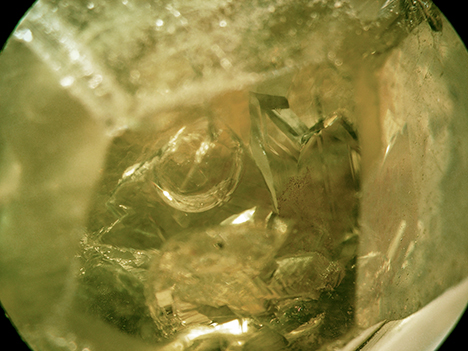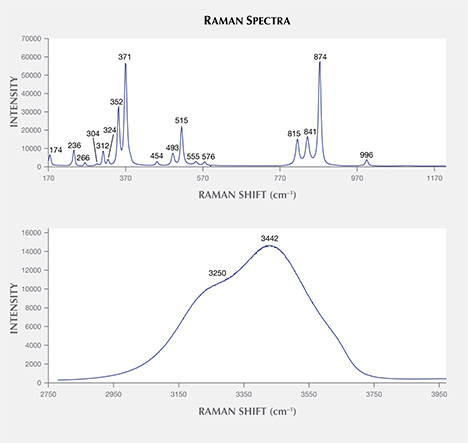Demantoid Garnet with Giant Fluid Inclusion

Since 2009 the Antetezambato demantoid garnet deposit, near Ambanja, in the Ambato peninsula of northern Madagascar, has yielded a huge quantity of rough gem material. This skarn-related deposit continues to produce fine crystals for the international market in a wide range of colors (F. Pezzotta et al., “Demantoid and topazolite from Antetezambato, northern Madagascar: Review and new data,” Spring 2011 G&G, pp. 2–14). Mineralogical curiosities were also found, such as demantoid garnet fossil pseudomorphs of gastropod and coral (Winter 2013 GNI, pp. 257–258; J. Raoul et al., “Pseudomorphose de fossiles en andradite ‘démantoïde’ à Antetezambato, Madagascar,” le Règne Minéral, Vol. 123, 2015, pp. 21–26). An andradite crystal (figure 1) hosting a giant two-phase (liquid + vapor) fluid inclusion (FI) was extracted from the mangrove swamps and is now the property of M. J. Raoul.
The greenish gem crystal, measuring 1.5 × 0.6 cm (figure 2A), exhibits some faces that follow a more dodecahedral habit {110} while others are more trapezoidal {110}. Micro-Raman spectroscopy clearly showed the four main peaks of andradite at 352, 371, 515, and 874 cm–1 (figure 3, top). The bubble of the FI cavity is visible to the naked eye and moves when the sample is turned, similar to some giant FI in quartz. The demantoid garnet was investigated by X-ray computed tomography (CT) scanning to reveal its 3D interior morphology. Images were made with a Phoenix Nanotom S scanner using a resolution of 7.59 μm/voxel and an X-ray tube on nanofocus tension of 115 kV. The calculation of all the phases was computed by VGStudio software, and the volumes of the respective phases are the sums of voxels. The 3D tomography images show a unique fluid inclusion cavity (figure 2B) with a morphology like a negative crystal with polygonal outlines parallel to the faces of the host garnet crystal (figures 2C, D). All the criteria define a primary two-phase FI. The total volume of the garnet is 896.1 mm3, of which 6.2 vol.% is occupied by the FI cavity. The volume of the liquid phase is 52.16 mm3 and the volume of the vapor phase is 3.52 mm3, which corresponds to a liquid/vapor ratio of 6.75%.


The Raman spectrometry data show that the fluid is free of CO2, CH4, H2S, and N2: the FI is a primary two-phase aqueous FI (liquid + vapor). The salinity of the aqueous FI was determined by analyzing the Raman spectrum of H2O based on the weakening of the hydrogen bond by chloride. A deformation of the OH stretching vibration band of water appears in the range between 2900 and 3700 cm–1 (figure 3, bottom). Even if the cationic composition of the natural FI differs from pure sodium, the experimental approach yields the salinity of any inclusion accurately if NaCl is the main species (M.-C. Caumon et al., “Fused-silica capillary capsules (FSCCs) as reference synthetic aqueous fluid inclusions to determine chlorinity by Raman spectroscopy,” European Journal of Mineralogy, Vol. 25, No. 4, 2014, pp. 755–763). Under these conditions the calculated salinity for the demantoid garnet FI is about 8 wt.% equivalent NaCl.
The gem garnet mineralization of Antetezambato is described as a skarn-type deposit related to Upper Mesozoic to Cenozoic magmatism affecting the limestones of the Mesozoic Isalo Group (again, see Pezzotta et al., 2011). Similar demantoid-bearing skarns are described in the Ampasindava Peninsula at Ambohimirahavavy, 50 km west of Ambanja (G. Estrade et al., “REE and HFSE mineralization in peralkaline granites of the Ambohimirahavavy alkaline complex, Ampasindava peninsula, Madagascar,” Journal of African Earth Sciences, Vol. 94, 2014, pp. 141–155). The skarns of the Ambohimirahavavy alkaline granitioid complex are host to rare-metal mineralization. Peralkaline dykes intruded (at 24.2 ± 0.6 Ma) the limestone of the Isalo groups (G. Estrade et al., “Unusual evolution of silica-under- and -oversaturated alkaline rocks in the Cenozoic Ambohimirahavavy Complex (Madagascar): Mineralogical and geochemical evidence,” Lithos, Vol. 206–207, 2014, pp. 361–383) and developed a bi-metasomatic skarn. The metasomatic zone was formed at the contact with the calcareous rocks by calc-silicate rocks (exo-skarn zone) with diopside, garnet andradite (demantoid variety), calcite, apatite, phlogopite, fluorite, and wollastonite. At the contact of the granite (endo-skarn zone), the associated minerals are quartz, albite, aegirine-augite, and calcite (G. Estrade, “Le complexe cénozoïque alcalin d’Ambohimirahavavy à Madagascar: origine, évolution et minéralisations en métaux rares,” PhD thesis, Paul Sabatier University, Toulouse, France, 2014, 299 pp.) Exo-skarn paragenesis is also found as inclusions in the demantoid of Antetezambato, such as fluorine-(arsenic)-bearing apatite, fluorite, calcite, wollastonite, fluorine-bearing vesuvianite, diopside, calcite, and quartz (W. Barrois et al., “Caractéristiques minéralogique et chimique des grenats démantoides de Bagh Borj (Iran) et d’Antetezambato (Madagascar): conséquences géologiques. 2ème partie, Études minéralogique et chimique,” Revue de Gemmologie a.f.g., Vol. 183, 2013, pp. 10–15, in French).
Fluid inclusions were observed in all the minerals of the exo- and endo-skarns of the Ambohimirahavavy alkaline complex, but they were too small in the garnet for microthermometric studies. In quartz, calcite, and diopside, three types of primary aqueous FI, free of CO2, CH4, H2S, and N2, were characterized (see Estrade’s PhD thesis). The main FI type (liquid + vapor) consists of 20 to 40 vol.% vapor, and homogenizes to liquid between 255 and 375°C for quartz, and 350 to 370°C for diopside, with a wide range of salinity between 0.5 and 25 wt.% equivalent NaCl. There is also a vapor-rich (V) FI and a halite-bearing FI (liquid + vapor + halite). The giant liquid-rich FI (liquid + vapor) trapped by the demantoid of Antetezambato has a salinity of 8 wt.% equivalent NaCl that falls within the salinity range of the (liquid + vapor) FI type found for all the minerals from the Ambohimirahavavy skarn.
Such chemical and salinity similarities of the fluids between the two settings confirm that the Antetezambato deposit is associated with a skarn deposit linked to the intrusion of Oligocene alkaline magmatism. In the Ambohimirahavavy deposit, fluid inclusions in garnet are too small to be studied by microthermometry. The giant inclusion trapped in the demantoid from Antetezambato testifies to the presence of cavities favorable for fluid inclusion studies and proves that the parental fluid of demantoid garnet was aqueous.
Demantoid at Ambato peninsula is linked to the presence of alkaline magmas intruding limestones of the Isalo group. These garnets are Cr-free but contain Al (Barrois et al., 2013). The source of aluminum and iron is the alkaline magma (syenite, nepheline syenite, and alkaline granite), while calcium originated from the limestone. The fluorine and phosphorus-bearing inclusions trapped by the andradite from both occurrences were carried by the alkaline magma, which was rich in fluorine, phosphorus, and rare earth elements. In the future, primary skarn-type demantoid-bearing deposits in northwestern Madagascar at the contact between alkaline granite dykes and limestone from the Isalo Group should be prospected for this material.



